Ever wondered why some terrariums flourish while others struggle? The answer often lies beneath the surface—literally. A well-balanced terrarium substrate acts as the backbone of these miniature ecosystems, shaping plant health and sustainability.
Like a cocktail recipe, the right mix depends on the environment. Tropical setups thrive with moisture-retaining blends, while arid landscapes need fast-draining materials. Pre-made mixes offer simplicity, but DIY options allow full control over texture and nutrients.
Drainage, aeration, and hydration matter just as much as aesthetics. Unsustainable choices like peat moss can harm the environment, while alternatives like coco coir provide eco-friendly solutions. For deeper insights, explore this terrarium substrate guide.
Key Takeaways
- Substrate determines water flow, root health, and nutrient access
- Tropical and desert terrariums need completely different mixes
- Layering prevents waterlogging and supports plant roots
- Sustainable materials like coco coir outperform traditional peat moss
- Sterilization prevents mold and pests in closed environments
Why Substrate Matters in Your Terrarium
Think of terrarium substrate as the foundation of a house—without proper support, everything collapses. This hidden layer does more than hold plants in place. It regulates moisture, delivers nutrients, and prevents root rot.
The Role of Substrate in Plant Health
Healthy roots need oxygen as much as water. Compacted soil suffocates them, while loose, airy mixes let roots breathe. A balanced blend includes:
- 40% moisture-retaining base (like coco coir)
- 50% drainage materials (orchid bark or perlite)
- 10% nutrient sources (compost or worm castings)
Sphagnum moss shows nature’s genius—it holds 20 times its weight in water. But it’s not just about hydration. The right pH (5.5-6.5) helps plants absorb minerals through cation exchange.
How Substrate Affects Moisture and Drainage
Tropical plants and desert succulents have opposite needs. One thrives in constant dampness, the other in quick-drying grit. This table shows how materials compare:
| Material | Water Retention | Best For |
|---|---|---|
| Aquarium soil | High | Bog plants |
| Orchid bark | Medium | Epiphytes |
| Perlite | Low | Succulents |
Poor drainage causes root rot—a silent killer. Earthworm castings add bioactive benefits, breaking down waste into plant food. For proper layering techniques, see this terrarium layer guide.
Light, fluffy textures prevent mold. Charcoal absorbs toxins, while tree fern fiber adds structure. It’s a delicate balance—like baking the perfect cake.
Types of Terrarium Substrates
From desert grit to tropical fluff, substrates shape miniature worlds. The ideal blend depends on a plant’s roots, water needs, and native habitat. Below, explore four core mixes and their superpowers.
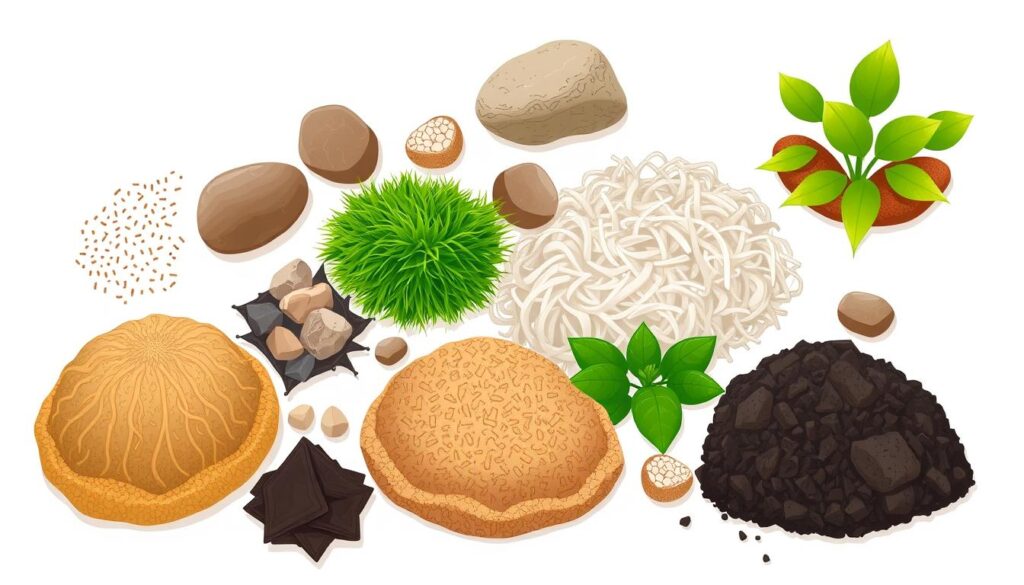
Potting Mix: Versatile and Beginner-Friendly
Standard potting mix works like a Swiss Army knife. It combines peat moss, perlite, and vermiculite for balanced moisture and drainage. Brands like Espoma Organic Potting Mix offer pH-neutral blends (6.0-6.5), safe for ferns and fittonias.
For tropical plants, tweak the ratio: 2 parts coco coir, 1 part orchid bark, 1 part worm castings. This boosts aeration while holding humidity.
Cactus/Succulent Mix: Ideal for Arid Environments
Cactus mixes laugh at water. They’re 70% inorganic—think pumice, coarse sand, or lava rock. Miracle-Gro’s version drains fast, mimicking desert beds. pH leans alkaline (6.5-7.0), preventing root rot in succulents.
“Sustainable mixes swap peat moss for coconut coir, saving 8,000 liters of water per ton produced.”
Orchid Bark Mix: Perfect for Epiphytic Plants
Orchids and air plants demand chunky orchid bark. Its large particles mimic tree branches, letting aerial roots breathe. Add charcoal to neutralize toxins—a trick from terrarium substrate pros.
| Mix Type | pH Range | Best For | Cost per ft³ |
|---|---|---|---|
| Potting | 6.0-6.5 | Ferns, Fittonia | $5-$10 |
| Cactus | 6.5-7.0 | Succulents | $8-$15 |
| Orchid Bark | 5.5-6.0 | Epiphytes | $12-$25 |
Terrarium-Specific Mixes: Convenience and Balance
Pre-made terrarium blends save time. They balance pH (6.0-6.5), include charcoal, and skip harmful additives. Bioactive versions add microbes, breaking down waste naturally. For fussy plants, these mixes are worth the splurge.
DIY Terrarium Substrate Mixes
Crafting your own terrarium mix lets you fine-tune textures, nutrients, and moisture levels. Unlike pre-made options, custom blends cater to specific plant needs—whether it’s a tropical paradise or a desertscape.
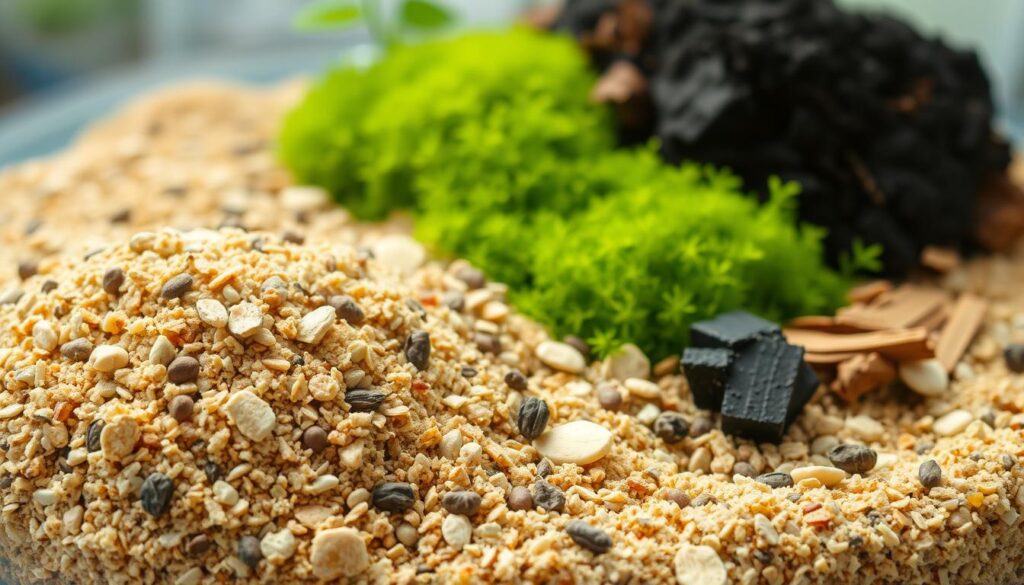
Essential Ingredients for a Balanced Mix
Every great mix starts with three core components:
- Base (40%) – Holds moisture (coco coir, sphagnum moss)
- Structure (50%) – Ensures drainage (orchid bark, perlite)
- Nutrients (10%) – Feeds plants (worm castings, compost)
Quality matters. Coco coir costs $0.50/oz versus sphagnum moss at $1.20/oz, but both excel at water retention. A pH meter ($15-$30) helps balance acidity—most plants thrive between 5.5-6.5.
Recipe for a Classic Tropical Terrarium Substrate
This tropical mix mimics rainforest floors:
- Combine 2 parts coco coir (moisture)
- Add 2 parts orchid bark (aeration)
- Mix in 1 part worm castings (nutrients)
- Finish with 1 part coarse sand (drainage)
“The squeeze test never lies—grab a handful. If water drips, add more bark. If it crumbles, boost coir.”
Adapting Your Mix for Different Plant Needs
Desert dwellers need grit. Swap the tropical recipe to:
- 40% sand (fast drainage)
- 30% pumice (lightweight structure)
- 20% coco coir (minimal moisture)
- 10% charcoal (toxin control)
For epiphytes like air plants, skip soil entirely. Use chunky orchid bark with sphagnum moss wraps. Always sterilize components at 200°F (93°C) for 30 minutes to kill pests.
| Mix Type | Key Ingredient | Best For |
|---|---|---|
| Tropical | Coco coir | Ferns, mosses |
| Desert | Coarse sand | Succulents |
| Epiphyte | Orchid bark | Air plants |
Understanding Terrarium Substrate Layers
Layering is the secret sauce for a thriving terrarium. Each tier has a specific job—from draining excess water to filtering toxins. Get these layers right, and plants will reward you with lush growth.
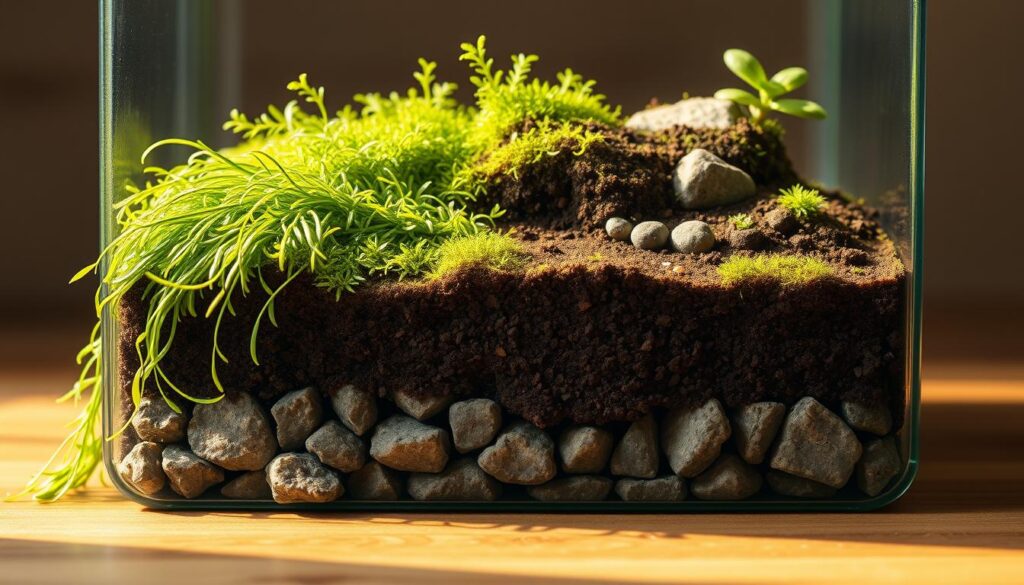
The Drainage Layer: Preventing Root Rot
This bottom layer stops roots from drowning. LECA (lightweight expanded clay aggregate) is a top pick—it’s porous and reusable. For small 2L containers, use 0.5 inches. Larger 10L setups need 1.5 inches.
Other options include:
- Gravel – Cheap but heavy
- Perlite – Lightweight but floats when wet
“Root rot kills more terrariums than pests. A proper drainage layer acts like a safety net.”
The Filtration Layer: Keeping the Ecosystem Clean
Sandwiched between drainage and substrate, this thin layer purifies water. Activated charcoal is the MVP—it traps benzene and formaldehyde. Avoid BBQ charcoal—it lacks the porous structure needed for filtration.
Key tips:
- Use horticultural-grade charcoal
- Keep layer thickness at 5% of total depth
- Replace every 6-12 months
The Substrate Layer: Planting and Support
This is where roots spread and feed. Aim for 65% of container volume. Tropical mixes need 2 inches minimum, while desert setups work with 1 inch.
| Plant Type | Ideal Depth | Key Ingredient |
|---|---|---|
| Ferns | 2.5 inches | Coco coir |
| Succulents | 1 inch | Coarse sand |
Vertical terrariums need special care. Stack layers at a slight angle so water flows downward. Test drainage by pouring 1/4 cup water—it should reach the bottom within 30 seconds.
Top Substrate Ingredients and Their Benefits
Behind every lush terrarium lies a carefully curated blend of powerhouse ingredients. Each component—from moisture-trapping fibers to toxin-fighting granules—plays a critical role in plant survival. Here’s how to pick the best allies for your miniature ecosystem.
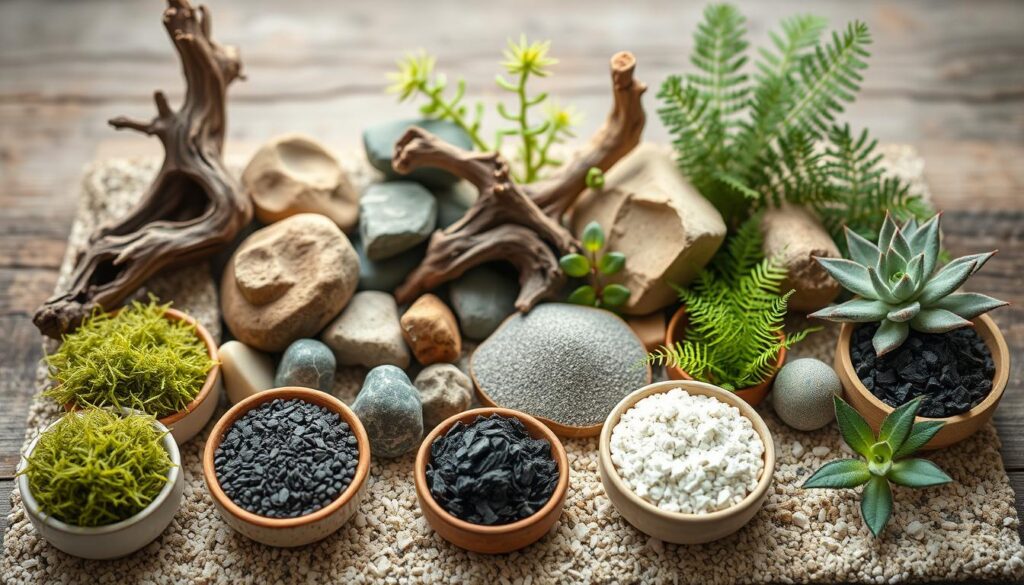
Coco Coir: Sustainable and Moisture-Retentive
Made from coconut husks, coco coir holds 8x its weight in water—perfect for tropical setups. Its pH (5.8–6.8) suits most plants, and it decomposes slower than peat moss. Lab tests show it outperforms peat in moisture retention by 15%.
- Eco-win: Saves 8,000 liters of water per ton compared to peat
- Versatile: Blends well with bark or perlite for aeration
Sphagnum Moss: Antimicrobial and Fluffy
This fluffy superstar reduces decay by 40% thanks to natural antibacterial properties. It’s ideal for moss walls or wrapping epiphyte roots. Always source ethically—look for USDA-certified harvests.
“Sphagnum’s hollow cells act like tiny sponges, releasing water slowly to prevent mold.”
Activated Charcoal: Toxin Absorption and Aeration
With a surface area of 500–1,500 m²/g, activated charcoal traps odors and chemicals. It’s a must for closed terrariums. Electron microscope images reveal its porous structure—like a labyrinth for toxins.
| Type | Pore Size | Best Use |
|---|---|---|
| Fine | 0.5–2 nm | Small terrariums |
| Coarse | 2–5 nm | Bioactive setups |
Orchid Bark: Natural Structure and Drainage
Chunky orchid bark mimics tree branches, letting roots breathe. Grades matter:
- Fine (0.25″): Seedlings
- Medium (0.5″): Most terrariums
- Chunky (1″): Large epiphytes
It lasts 2–3 years before breaking down—longer than coco coir.
Choosing the Right Substrate for Your Terrarium Plants
Not all terrarium plants thrive in the same soil—some crave moisture while others demand grit. Matching their native environment prevents root rot or dehydration. Below, explore specialized blends for popular varieties.
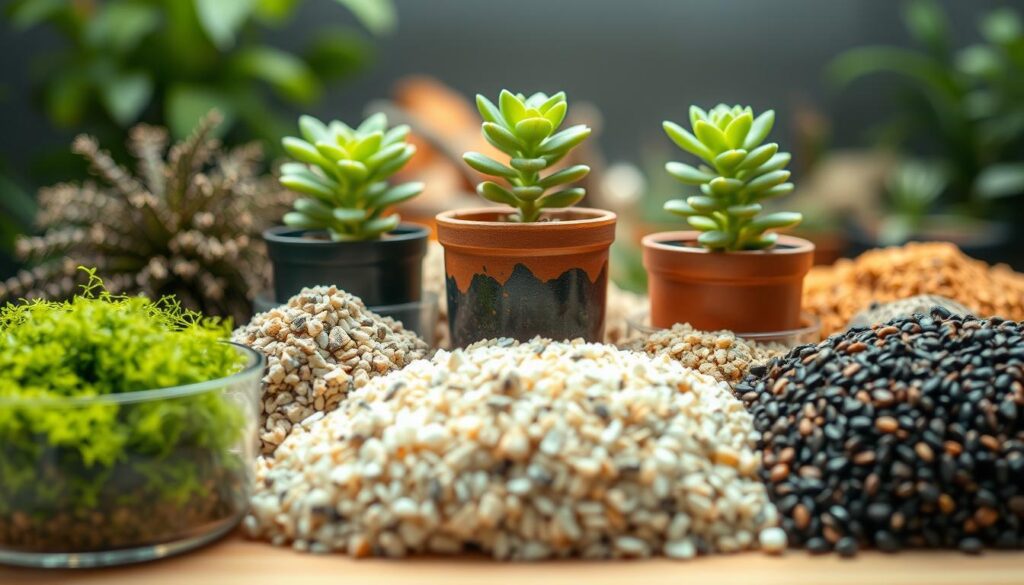
Tropical Plants: Humidity-Loving Foundations
Ferns and mosses need 60-80% humidity retention. A winning mix combines:
- 3 parts coco coir (holds moisture without compaction)
- 1 part sphagnum moss (antibacterial properties)
- 1/2 part charcoal (toxin filtration)
Keep pH slightly acidic (5.5-6.0). Peperomia grows 30% faster in this blend versus standard potting soil.
Succulents and Cacti: The Desert Treatment
These drought-tolerant plants require
- 50% coarse sand (drainage)
- 30% pumice (aeration)
- 20% crushed granite (mineral boost)
Overwatering kills more cactus than neglect. Test drainage—water should disappear in 10 seconds.
| Plant Type | Key Ingredient | Watering Frequency |
|---|---|---|
| Ferns | Coco coir | Every 3 days |
| Air Plants | Orchid bark | Mist weekly |
| Succulents | Coarse sand | Every 14 days |
Signature Designs: Beyond Basic Blends
For a Mossarium, layer sphagnum moss over clay balls. Desertscapes shine with red lava rock topping. Vertical gardens need angled layers—use mesh pockets for epiphytes.
“Switching from peat to coco coir revived my dying maidenhair fern in 2 weeks.” — Seattle Terrarium Club
Adjust pH naturally: limestone raises it, sulfur lowers it. Always sterilize sand at 200°F (93°C) to kill pathogens.
Bioactive Substrates for Terrariums
Nature’s cleanup crew thrives in bioactive setups. These living substrates transform waste into nutrients, creating a self-cleaning ecosystem. Unlike traditional mixes, they host microfauna that recycle organic matter 24/7.
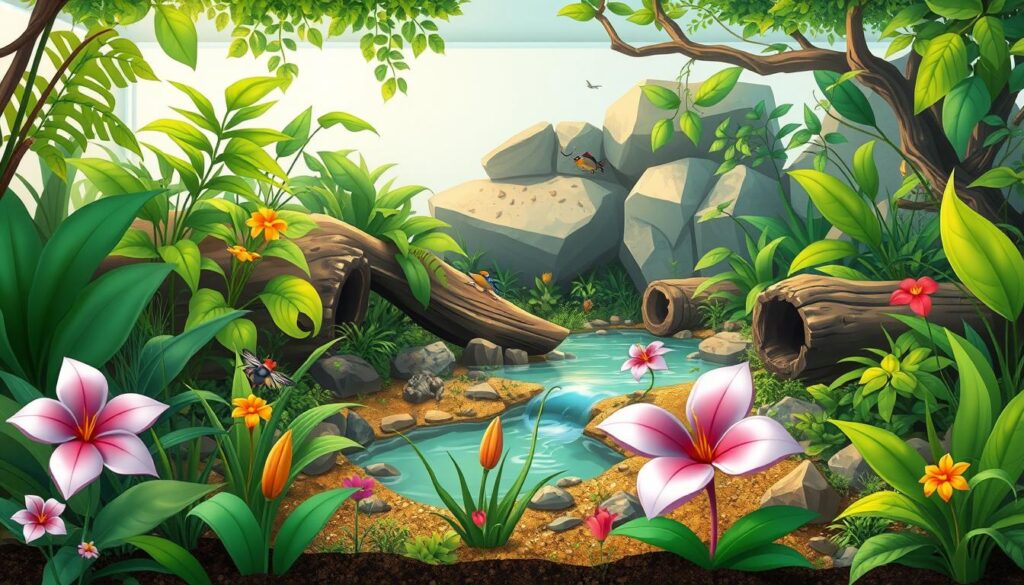
What Makes a Substrate Bioactive?
Bioactive blends contain three key ingredients:
- 20% organic matter (leaf litter, hardwood mulch)
- Microorganisms (beneficial bacteria, fungi)
- Cleanup crews (springtails, isopods)
These components work together like a tiny recycling plant. Springtails alone process waste 300% faster than manual cleaning. Their populations range from 50-100 per cubic inch in healthy setups.
Ingredients to Support Microfauna
The right mix keeps custodial species thriving:
| Ingredient | Purpose | Amount |
|---|---|---|
| Magnolia leaves | Slow-decay food source | 5-10 leaves |
| Cork bark | Isopod hiding spots | 2-3 pieces |
| Charcoal | Toxin filtration | 1/4 cup per gallon |
“My isopod colony eliminated mold problems completely within two weeks.” — Portland BioTerrarium Society
For balanced health, follow this feeding schedule:
- Weekly: Sprinkle fish flakes for protein
- Monthly: Add calcium-rich cuttlebone
- Quarterly: Replace 30% leaf litter
Benefits of a Self-Sustaining Ecosystem
Bioactive systems offer unique advantages:
- 90% mold reduction compared to sterile substrates
- Natural humidity regulation through decomposition
- Continuous nutrient cycling for plant health
Closed terrariums particularly benefit. The nitrogen cycle completes naturally, as detailed in this bioactive substrate guide. Always quarantine new microfauna for 14 days to prevent parasite introduction.
Commercial kits simplify startup, but DIY mixes allow customization. Sterilize non-living components at 200°F (93°C), then inoculate with cultured microorganisms for best results.
Common Substrate Mistakes to Avoid
Data reveals 68% of terrarium failures trace back to three preventable substrate errors. Whether it’s waterlogged roots or toxic additives, these missteps can turn a lush paradise into a wasteland. Here’s how to sidestep the pitfalls.
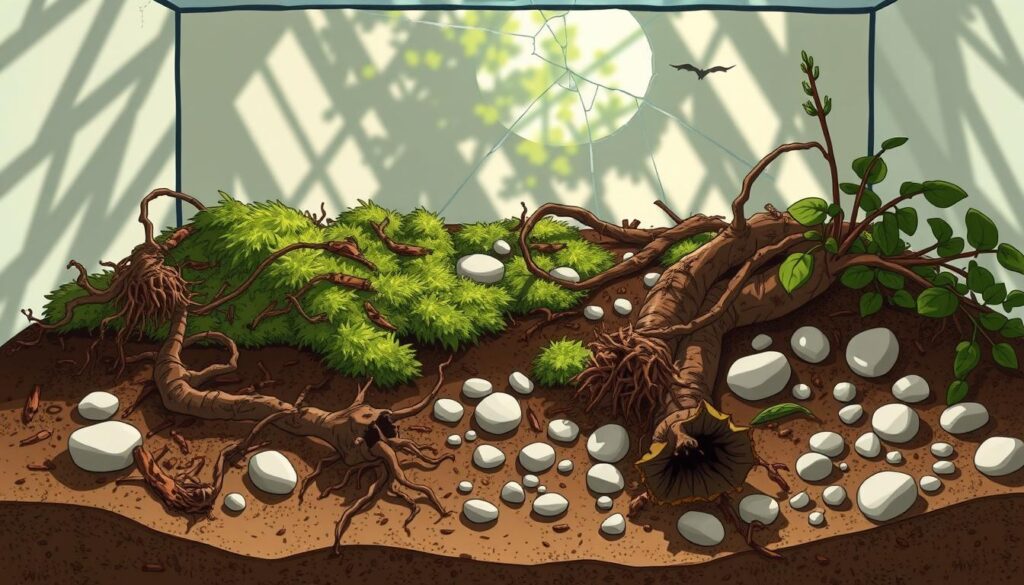
Overwatering and Poor Drainage
Root rot kills more terrariums than pests. CT scans show waterlogged roots suffocate within 72 hours. Signs include yellow leaves and a musty smell.
- Fix it: Use a 1:1 ratio of orchid bark to coco coir for faster drainage.
- Test: Pour water—if it pools longer than 30 seconds, add perlite.
Using Unsustainable or Harmful Ingredients
Peat moss harvesting destroys 94,000 acres annually. Worse, some commercial mixes contain hidden toxins like fertilizer balls or styrofoam.
| Ingredient | Eco-Alternative | Savings |
|---|---|---|
| Peat moss | Coco coir | 8,000L water/ton |
| Vermiculite | Pumice | Non-toxic |
“Switching to coco coir reduced my terrarium mortality rate by 40%.” — Chicago Plant Enthusiasts
Neglecting to Sterilize Substrate
Unsterilized soil hosts 1 million microorganisms per gram. Mold outbreaks often start here.
- Oven method: Bake at 200°F (93°C) for 30 minutes.
- Microwave: Damp soil in a bowl for 90 seconds.
For compromised setups, replace the top 2 inches of substrate and add springtails to combat mold.
Conclusion
Great terrariums mirror nature’s perfect soil recipes. Match substrate to plant needs—tropical blends for ferns, gritty mixes for succulents. Container size and sustainability matter just as much as texture.
Long-term success hinges on drainage checks and occasional refreshes. Don’t fear DIY experiments; custom blends often outperform store-bought. Soil test kits ($12-$20) help fine-tune pH.
Every choice impacts real ecosystems. Swap peat for coco coir to save water. Share your mix recipes in the comments!
For quick reference, grab our free guide on layering techniques. Next up: mastering terrarium lighting for peak plant health. Remember, a strong foundation means a thriving miniature environment.
FAQ
What’s the best substrate for tropical terrarium plants?
Can regular potting soil be used in a terrarium?
Why is activated charcoal added to terrarium substrate?
How often should terrarium substrate be replaced?
Do succulents need special substrate in terrariums?
What’s the purpose of a drainage layer in terrariums?
Can I reuse old terrarium substrate?
Is leaf litter a good addition to terrarium substrate?

I’m Lena Adams—a product of an unconventional upbringing in the African wilderness. My father, a daring explorer of African wildlife, sparked my fascination with reptiles, a passion that intertwined with the tragic loss of my mother during an expedition, leaving an indelible mark on my life. Driven to understand the creatures that captivated my parents, I embarked on my journey, sharing insights about reptiles, frogs, and lizards on my website. Through my explorations and conservation efforts, I honour my family’s legacy while seeking connections—to the creatures, nature, and the mother whose presence I yearn to understand.
